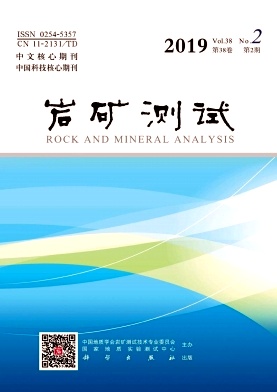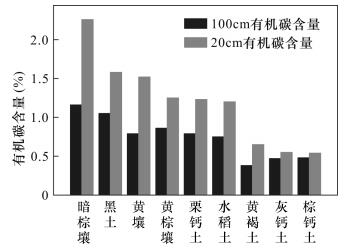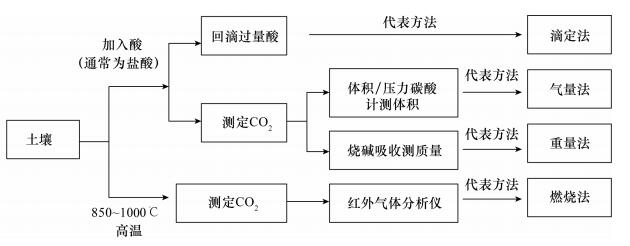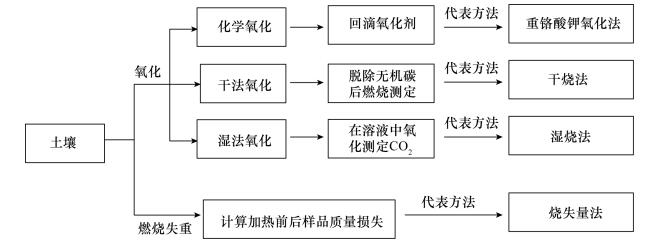| [1] |
Mohamed A, Mohamed E, Abd-ElAziz B.Effect of land-use changes and site variables on surface soil organic carbon pool at Mediterranean region[J].Journal of African Earth Sciences, 2016, 114:78-84. doi: 10.1016/j.jafrearsci.2015.11.020
CrossRef Google Scholar
|
| [2] |
Marty C, Houle D, Gagnon C.Variation in stocks and distribution of organic C in soils across 21 Eastern Canadian temperate and boreal forests[J].Forest Ecology & Management, 2015, 345:29-38.
Google Scholar
|
| [3] |
Baldock J A.Composition and Cycling of Organic Carbon in Soil[M]//Nutrient Cycling in Terrestrial Ecosystems.Springer Berlin Heidelberg, 2007:826-844.
Google Scholar
|
| [4] |
Adenuga O S, Ajiboye G A, Shade J, et al.Siol Carbon[M].Springer International Publishing Swizerland, 2014:27-28.
Google Scholar
|
| [5] |
Wang X J, Xu M G, Wang J P, et al.Fertilization enhan-cing carbon sequestration as carbonate in arid cropland:Assessments of long-term experiments in Northern China[J]. Plant and Soil, 2014, 380(1-2):89-100. doi: 10.1007/s11104-014-2077-x
CrossRef Google Scholar
|
| [6] |
Batjies N H.Total carbon and nitrogen in the soil of the world[J].European Journal of Soil Science, 1996, 47(2):151-163. doi: 10.1111/ejs.1996.47.issue-2
CrossRef Google Scholar
|
| [7] |
Zhang F, Wang X J, Guo T W, et al.Soil organic and inorganic carbon in the loess profiles of Lanzhou area:Implications of deep soils[J].Catena, 2015, 126:68-74. doi: 10.1016/j.catena.2014.10.031
CrossRef Google Scholar
|
| [8] |
Wu H B, Guo Z T, Gao Q, et al.Distribution of soil inorganic carbon storage and its changes due to agricultural land use activity in China[J].Agriculture, Ecosystems and Environment, 2009, 129(4):413-421. doi: 10.1016/j.agee.2008.10.020
CrossRef Google Scholar
|
| [9] |
马逸麟, 郄海满, 彭晓玫, 等.江西省鄱阳湖及周边经济区土壤有机碳储量分布特征[J].岩矿测试, 2014, 34(2):246-255. doi: 10.3969/j.issn.0254-5357.2014.02.016
CrossRef Google Scholar
Ma Y L, Qie H M, Peng X M, et al.The reserve distribution characteristics of organic carbon in soil from Poyang Lake and the surrounding economic region[J].Rock and Mineral Analysis, 2014, 34(2):246-255. doi: 10.3969/j.issn.0254-5357.2014.02.016
CrossRef Google Scholar
|
| [10] |
Tan W F, Zhang R, Cao H, et al.Soil inorganic carbon stock under different soil types and land uses on the Loess Plateau region of China[J]. Catena, 2014, 121:22-30.
Google Scholar
|
| [11] |
Li Z P, Han F X, Su Y, et al.Assessment of soil organic and carbonate carbon storage in China[J].Geoderma, 2007, 138(1-2):119-126. doi: 10.1016/j.geoderma.2006.11.007
CrossRef Google Scholar
|
| [12] |
Shi H J, Wang X J, Zhao Y J, et al.Relationship between soil inorganic carbon and organic carbon in the wheat-maize cropland of the North China Plain[J].Plant & Soil, 2017, 18(1-2):1-14.
Google Scholar
|
| [13] |
Xie J X, Li Y, Zhai C X, et al.CO2 absorption by alkaline soils and its implication to the global carbon cycle[J].Environmental Geology, 2009, 56(5):953-961. doi: 10.1007/s00254-008-1197-0
CrossRef Google Scholar
|
| [14] |
Xu N Z, Zhang T L, Wang X X, et al.Statistical calculation of soil inorganic carbon stock in the Yangtze Delta region[J].Resources and Environment in the Yangtze Basin, 2009, 18(11):1038-1044.
Google Scholar
|
| [15] |
Alireza R, Ahmad H, Shahla M.Organic and inorganic carbon storage in soils along an arid to dry sub-humid climosequence in northwest of Iran[J].Cetena, 2017, 153:66-74. doi: 10.1016/j.catena.2017.01.035
CrossRef Google Scholar
|
| [16] |
Zhao W, Zhang R, Huang C, et al.Effect of different vegetation cover on the vertical distribution of soil organic and inorganic carbon in the Zhifanggou watershed on the loess plateau[J].Catena, 2016, 139(3):191-198.
Google Scholar
|
| [17] |
Mi N W, Shao Q, Liu J Y, et al.Soil inorganic carbon storage pattern in China[J].Global Change Biology, 2008, 14(10):2380-2387. doi: 10.1111/gcb.2008.14.issue-10
CrossRef Google Scholar
|
| [18] |
解宪丽, 孙波, 周慧珍, 等.中国土壤有机碳密度和储量的估算与空间分布分析[J].土壤学报, 2004, 41(1):35-43. doi: 10.3321/j.issn:0564-3929.2004.01.006
CrossRef Google Scholar
Xie X L, Sun B, Zhou H Z, et al.Organic carbon density and storage in soils of China and spatial analysis[J].Acta Preologica Sinica, 2004, 41(1):35-43. doi: 10.3321/j.issn:0564-3929.2004.01.006
CrossRef Google Scholar
|
| [19] |
Wang Y G, Li Y, Ye X H, et al.Profile storage of organic/inorganic carbon in soil:From forest to desert[J].Science of the Total Environment, 2010, 408(8):1925-1931. doi: 10.1016/j.scitotenv.2010.01.015
CrossRef Google Scholar
|
| [20] |
Syswerda S P, Corbin A T, Mokma D L, et al.Agri-cultural management and soil carbon storage in surface vs. deep layers[J].Soil Science Society of America Journal, 2011, 75(1):92-101. doi: 10.2136/sssaj2009.0414
CrossRef Google Scholar
|
| [21] |
Tong X G, Xu M G, Zhang W J, et al.Influence of long-term fertilization on content and distribution of organic carbon in particle-size fractions of red soil and fluvo-aquic soil in China[J].Scientia Agricultura Sinica, 2008, 41(11):3664-3671.
Google Scholar
|
| [22] |
Chen L C, Hua W, Xin Y, et al.Recovery time of soil carbon pools of conversional Chinese fir plantations from broadleaved forests in subtropical regions, China[J].Science of the Total Environment, 2017, 587-588:296-304. doi: 10.1016/j.scitotenv.2017.02.140
CrossRef Google Scholar
|
| [23] |
Yu P, Han K, Li Q, et al.Soil organic carbon fractions are affected by different land uses in an agro-pastoral transitional zone in Northeastern China[J].Ecological Indicators, 2016, 73:331-337.
Google Scholar
|
| [24] |
Sharma V, Hussain S, Sharma K R, et al.Labile carbon pools and soil organic carbon stocks in the foothill Himalayas under different land use systems[J].Geoderma, 2014, 232-234:81-87. doi: 10.1016/j.geoderma.2014.04.039
CrossRef Google Scholar
|
| [25] |
Han L, Sun K, Jin J, et al.Some concepts of soil organic carbon characteristics and mineral interaction from a review of literature[J].Soil Biology & Biochemistry, 2016, 94:107-121.
Google Scholar
|
| [26] |
Kucharik C J, Foley J A, Delire C, et al.Testing the performance of a dynamic global ecosystem model:Water balance carbon balance and vegetation structure[J].Global Biogeochemical Cycles, 2000, 14(3):795-825. doi: 10.1029/1999GB001138
CrossRef Google Scholar
|
| [27] |
Zhu L, Hu N, Yang M, et al.Effects of different tillage and straw return on soil organic carbon in a rice-wheat rotation system[J].PloS One, 2014, 9(2):e88900. doi: 10.1371/journal.pone.0088900
CrossRef Google Scholar
|
| [28] |
沈艳.岩溶区不同土地利用方式土壤碳形态特征的研究[D].重庆: 西南大学, 2013.http://cdmd.cnki.com.cn/Article/CDMD-10635-1013268606.htm
Google Scholar
Shen Y.Features of the Soil Organic Matter Fractions of Different Land Use Patterns in the Karst Areas[D].Chongqing: Southwest University, 2013.
Google Scholar
|
| [29] |
Leifeld J, Kögel-Knabner I.Soil organic matter fractions as early indicators for carbon stock changes under different land-use?[J].Geoderma, 2005, 124(1-2):143-155. doi: 10.1016/j.geoderma.2004.04.009
CrossRef Google Scholar
|
| [30] |
Song Y, Song C, Yang G, et al.Changes in labile organic carbon fractions and soil enzyme activities after marshland reclamation and restoration in the Sanjiang Plain in Northeast China[J].Environmental Management, 2012, 50(3):418. doi: 10.1007/s00267-012-9890-x
CrossRef Google Scholar
|
| [31] |
Jandl R, Sollins P.Water-extractable soil carbon in relation to the below ground carbon cycle[J].Biology and Fertility, 1997, 25(2):196-201.
Google Scholar
|
| [32] |
Zhang J, Song C, Wang S.Dynamics of soil organic carbon and its fractions after abandonment of cultivated wetlands in Northeast China[J].Soil & Tillage Research, 2007, 96(1-2):350-360.
Google Scholar
|
| [33] |
Biederbeck V O, Janzen H H, Campbell C A, et al.Labile soil organic matter as influenced by cropping practices in an arid environment[J].Soil Biology & Biochemistry, 1994, 26(12):1647-1656.
Google Scholar
|
| [34] |
Treseder K K.Nitrogen Additions and Microbial Biomass: A Global Meta-analysis[C]//AGU Fall Meeting Abstracts, 2008.https://www.researchgate.net/publication/252641121_Nitrogen_Additions_and_Microbial_Biomass_A_Global_Meta-analysis
Google Scholar
|
| [35] |
Wallenstein M D, Schlesinger W H, Rhee S K, et al. Effects of nitrogen fertilization on soil microbial communities[C]//Geophysical Research Abstracts.European Geophysical Society, 2003: 13087.
Google Scholar
|
| [36] |
Plaza-Bonilla D, Álvaro-Fuentes J, Cantero-Martínez C.Identifying soil organic carbon fractions sensitive to agricultural management practices[J].Soil & Tillage Research, 2014, 139:19-22.
Google Scholar
|
| [37] |
Li S, Zhang S, Pu Y, et al.Dynamics of soil labile organic carbon fractions and C-cycle enzyme activities under straw mulch in Chengdu Plain[J].Soil & Tillage Research, 2016, 155:289-297.
Google Scholar
|
| [38] |
Wang Z C, Liu S S, Huang C, et al.Impact of land use change on profile distributions of organic carbon fractions in peat and mineral soils in Northeast China[J].Catena, 2017, 152:1-8. doi: 10.1016/j.catena.2016.12.022
CrossRef Google Scholar
|
| [39] |
Cambardella C A, Elliott E T.Particulate soil organic-matter changes across a grassland cultivation sequence[J].Soil Science Society of America Journal, 1992, 56(3):777-783. doi: 10.2136/sssaj1992.03615995005600030017x
CrossRef Google Scholar
|
| [40] |
Solomon D, Fritzsche F, Tekalign M, et al.Soil organic matter composition in the sub-humid Ethiopian highlands as influenced by deforestation and agricultural management[J].Soil Science Society of America Journal, 2002, 66(1):68-82. doi: 10.2136/sssaj2002.6800
CrossRef Google Scholar
|
| [41] |
Smith P.Carbon sequestration in croplands:The potential in Europe and the global context[J].European Journal of Agronomy, 2004, 20(3):229-236. doi: 10.1016/j.eja.2003.08.002
CrossRef Google Scholar
|
| [42] |
Franzluebbers A J, Stuedemann J A.Particulate and non-particulate fractions of soil organic carbon under pastures in the Southern Piedmont USA[J].Environmental Pollution, 2002, 116(3):S53-S62.
Google Scholar
|
| [43] |
Gregorich B G, Beare M I J, Mckim U F, et al.Chemical and biological characteristics of physically uncomplexed organic matter[J].Soil Science Society of America Journal, 2006, 70(3):975-985. doi: 10.2136/sssaj2005.0116
CrossRef Google Scholar
|
| [44] |
Zeller B, Dambrine E.Coarse particulate organic matter is the primary source of mineral N in the topsoil of three beech forests[J].Soil Biology and Biochemistry, 2011, 43(3):542-550. doi: 10.1016/j.soilbio.2010.11.019
CrossRef Google Scholar
|
| [45] |
Falloon P D, Smith P.Modelling refractory soil organic matter[J].Biology and Fertility of Soils, 2000, 30(5):388-398.
Google Scholar
|
| [46] |
Conant R T, Six J, Paustian K.Land use effects on soil carbon fractions in the Southeastern United States.Ⅰ.Management-intensive versus extensive grazing[J].Biology and Fertility of Soils, 2003, 38(6):386-392. doi: 10.1007/s00374-003-0652-z
CrossRef Google Scholar
|
| [47] |
Zougagh M, Rios A, Valcarcel M.Direct determination of total carbonate salts in soil samples by continuous-flow piezoelectric detection[J].Talanta, 2005, 65(1):29-35.
Google Scholar
|
| [48] |
Sherrod L A, Dunn G, Peterson G A, et al.Inorganic carbon analysis by modified pressure-calcimeter method[J].Soil Science, 2002, 66(1):299-305. doi: 10.2136/sssaj2002.2990
CrossRef Google Scholar
|
| [49] |
王莲莲, 杨学云, 杨文静.土壤碳酸盐几种测定方法的比较[J].西北农业学报, 2013, 22(5):144-150.
Google Scholar
Wang L L, Yang X Y, Yang W J.Comparison of three methods for determination of soil carbonate[J].Acta Agriculturae Boreali-Occidentalis Sinica, 2013, 22(5):144-150.
Google Scholar
|
| [50] |
杜森, 高祥照.土壤分析技术规范[M].北京:中国农业出版社, 2006.
Google Scholar
Du S, Gao X Z.Soil Analysis Technical Specifications[M].Beijing:China Agriculture Press, 2006.
Google Scholar
|
| [51] |
彭红翠, 肖和艾, 吴金水, 等.土壤碳酸盐间接测定方法研究及其应用[J].土壤, 2006, 38(4):477-482. doi: 10.3321/j.issn:0253-9829.2006.04.021
CrossRef Google Scholar
Peng H C, Xiao H A, Wu J S, et al.An indirect method for determination of soil total carbonate[J].Soils, 2006, 38(4):477-482. doi: 10.3321/j.issn:0253-9829.2006.04.021
CrossRef Google Scholar
|
| [52] |
韩文娟.新疆天山北坡典型草地土壤无机碳特征[D].乌鲁木齐: 新疆农业大学, 2015.http://cdmd.cnki.com.cn/Article/CDMD-10758-1015645972.htm
Google Scholar
Han W J.Soil Inorganic Carbon Distribution Character-istics in Typical Grassland in North Slope of Tianshan Mountains of Xinjiang[D].Urumqi: Xinjiang Agricultural University, 2015.
Google Scholar
|
| [53] |
Bisutti I, Hilke I, Schumacher J, et al.A novel single-run dual temperature combustion (SRDTC) method for the determination of organic, inorganic and total carbon in soil samples[J].Talanta, 2007, 71(2):521. doi: 10.1016/j.talanta.2006.04.022
CrossRef Google Scholar
|
| [54] |
Apesteguia M, Plante A F, Virto I.Methods assessment for organic and inorganic carbon quantification in calcareous soils of the Mediterranean region[J].Geoderma Regional, 2018, 12:39-48. doi: 10.1016/j.geodrs.2017.12.001
CrossRef Google Scholar
|
| [55] |
Kimble J M, Lal R, Follett R F.Assessment Methods for Soil Carbon[M].Boca Raton:Lewis Publishers, 2001.
Google Scholar
|
| [56] |
Bisutti I, Hilke I, Raessler M.Determination of total organic carbon-An overview of current methods[J].TrAC Trends in Analytical Chemistry, 2004, 23(10-11):716-726. doi: 10.1016/j.trac.2004.09.003
CrossRef Google Scholar
|
| [57] |
杨剑虹, 王成林, 代亨林.土壤农化分析与环境监测[M].北京:中国大地出版社, 2008:27-34.
Google Scholar
Yang J H, Wang C L, Dai H L.Chemical Analysis and Environmental Monitoring of Soil[M].Beijing:China Earth Press, 2008:27-34.
Google Scholar
|
| [58] |
Ramnarine R, Voroney R P, Wagner R C, et al.Carbon-ate removal by acid fumigation for measuring the C of soil organic carbon[J].Canadian Journal of Soil Science, 2011, 91(2):247-250. doi: 10.4141/cjss10066
CrossRef Google Scholar
|
| [59] |
Senesi G S, Senesi N.Laser-induced breakdown spectro-scopy (LIBS) to measure quantitatively soil carbon with emphasis on soil organic carbon:A review[J].Analytica Chimica Acta, 2016, 938:7-17. doi: 10.1016/j.aca.2016.07.039
CrossRef Google Scholar
|
| [60] |
Benbi D K, Brar K, Toor A S, et al.Total and labile pools of soil organic carbon in cultivated and undisturbed soils in Northern India[J].Geoderma, 2015, 237-238:149-158. doi: 10.1016/j.geoderma.2014.09.002
CrossRef Google Scholar
|
| [61] |
Gong W, Hu T X, Wang J Y, et al.Soil carbon pool and fertility under natural evergreen broadleaved forest and its artificial regeneration forests in Southern Sichuan Province, China[J].Acta Ecologica Sinica, 2008, 28(6):2536-2545. doi: 10.1016/S1872-2032(08)60060-8
CrossRef Google Scholar
|
| [62] |
Luo S, Zhu L, Liu J, et al.Sensitivity of soil organic carbon stocks and fractions to soil surface mulching in semiarid farmland[J].European Journal of Soil Biology, 2015, 67:35-42. doi: 10.1016/j.ejsobi.2015.01.004
CrossRef Google Scholar
|
| [63] |
Loginow W, Wisniewski W, Gonet S S, et al.Fraction-ation of organic carbon based on susceptibility to oxidation[J].Polish Journal of Soil Science, 1987, 20(1):47-52.
Google Scholar
|
| [64] |
Blair G J, Lefroy R D B, Lisle L.Soil carbon fractions based on their degree of oxidation, and the development of a carbon management index for agricultural systems[J].Australian Journal of Agricultural Research, 1995, 46(7):1459-1466. doi: 10.1071/AR9951459
CrossRef Google Scholar
|
| [65] |
Weil R R, Islam K R, Stine M A, et al.Estimating active carbon for soil quality assessment:A simplified method for laboratory and field use[J].American Journal of Alternative Agriculture, 2003, 18(1):3-17. doi: 10.1079/AJAA2003003
CrossRef Google Scholar
|
| [66] |
党亚爱, 李世清, 王国栋, 等.黄土高原典型土壤有机碳和微生物碳分布特征的研究[J].自然资源学报, 2007, 22(6):936-945. doi: 10.3321/j.issn:1000-3037.2007.06.010
CrossRef Google Scholar
Dang Y A, Li S Q, Wang G D, et al.Distribution characteristics of soil organic carbon and microbial biomass carbon on the Loess Plateau[J].Journal of Natural Resources, 2007, 22(6):936-945. doi: 10.3321/j.issn:1000-3037.2007.06.010
CrossRef Google Scholar
|
| [67] |
Shahid M, Nayak A K, Puree C, et al.Carbon and nitro-gen fractions and stocks under 41 years of chemical and organic fertilization in a sub-humid tropical rice soil[J].Soil & Tillage Research, 2017, 170:136-146.
Google Scholar
|
| [68] |
Qi R, Li J, Lin Z, et al.Temperature effects on soil organic carbon, soil labile organic carbon fractions, and soil enzyme activities under long-term fertilization regimes[J].Applied Soil Ecology, 2016, 102:36-45. doi: 10.1016/j.apsoil.2016.02.004
CrossRef Google Scholar
|
| [69] |
Six J, Eilliot E T, Paustian K, et al.Aggregation and soil organic matter accumulation in cultivated and native grassland soils[J].Soil Science Society of America Journal, 1998, 62(5):1367-1377. doi: 10.2136/sssaj1998.03615995006200050032x
CrossRef Google Scholar
|
| [70] |
Wang X N, Geng Y Q, Yu X X.Soil total organic carbon and soil labile organic carbon fraction under quercus variabilis & pinus tabulaeformis forest[J].Chinese Journal of Soil Science, 2012, 43(3):604-609.
Google Scholar
|
| [71] |
Paul E A, Morris S J, Conant R T, et al.Does the acid hydrolysis-incubation method measure meaningful soil organic carbon pools[J].Soil Science Society of America Journal, 2006, 70(3):1023-1035. doi: 10.2136/sssaj2005.0103
CrossRef Google Scholar
|
| [72] |
Ramnarine R, Voroney R P, Dunfield K E, et al. Characterization of the heavy, hydrolysable and non-hydrolysable fractions of soil organic carbon in conventional and no-tillage soils[J]. Soil & Tillage Research, 2018, 181:144-151.
Google Scholar
|
| [73] |
Li S Q, Zheng X H, Liu C Y, et al.Influences of observation method, season, soil depth, land use and management practice on soil dissolvable organic carbon concentrations:A meta-analysis[J].Science of the Total Environment, 2018, 631-632:105-114. doi: 10.1016/j.scitotenv.2018.02.238
CrossRef Google Scholar
|
| [74] |
Andres G D, Maria J M, Blanca S, et al.Labile and stable soil organic carbon and physical improvements using ground covers in vineyards from Central Spain[J].Science of the Total Environment, 2018, 621:387-397. doi: 10.1016/j.scitotenv.2017.11.240
CrossRef Google Scholar
|
| [75] |
Lagomarsino A, Benedetti A, Marinari S, et al.Soil organic C variability and microbial functions in a Mediterranean agro-forest ecosystem[J].Biology and Fertility of Soils, 2011, 47(3):283-291. doi: 10.1007/s00374-010-0530-4
CrossRef Google Scholar
|
| [76] |
Roscoe R, Buurman P.Tillage effects on soil organic matter in density fractions of a Cerrado Oxisol[J].Soil & Tillage Research, 2003, 70(2):107-119.
Google Scholar
|
| [77] |
徐嘉晖, 高雷, 孙颖, 等.大兴安岭森林土壤矿物结合态有机碳与黑碳的分布及土壤固碳潜力[J].土壤学报, 2018, 55(1):236-246.
Google Scholar
Xu J H, Gao L, Sun Y, et al.Distribution of mineral-bonded organic carbon and black carbon in forest soils of Great Xing'an Mountains, China and carbon sequestration potential of the soils[J].Acta Pedological Sinica, 2018, 55(1):236-246.
Google Scholar
|







 DownLoad:
DownLoad:

